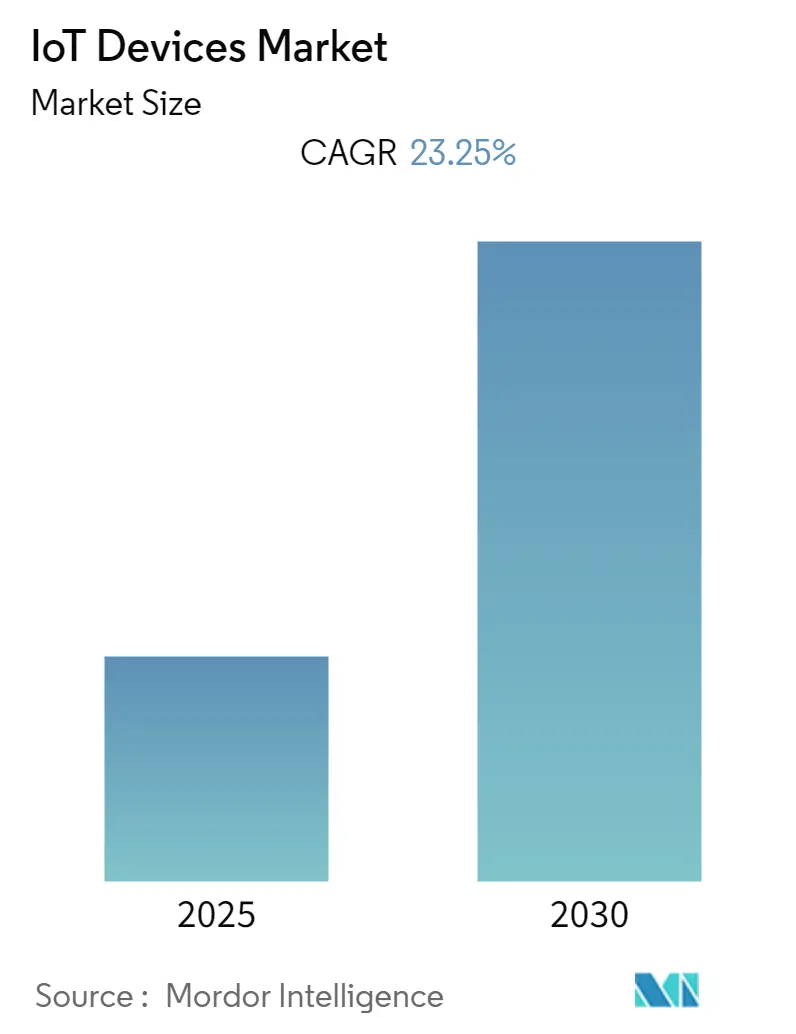
| Study Period | 2019 - 2030 |
| Base Year For Estimation | 2024 |
| Forecast Data Period | 2025 - 2030 |
| CAGR | 23.25 % |
| Fastest Growing Market | Asia Pacific |
| Largest Market | North America |
| Market Concentration | Low |
Major Players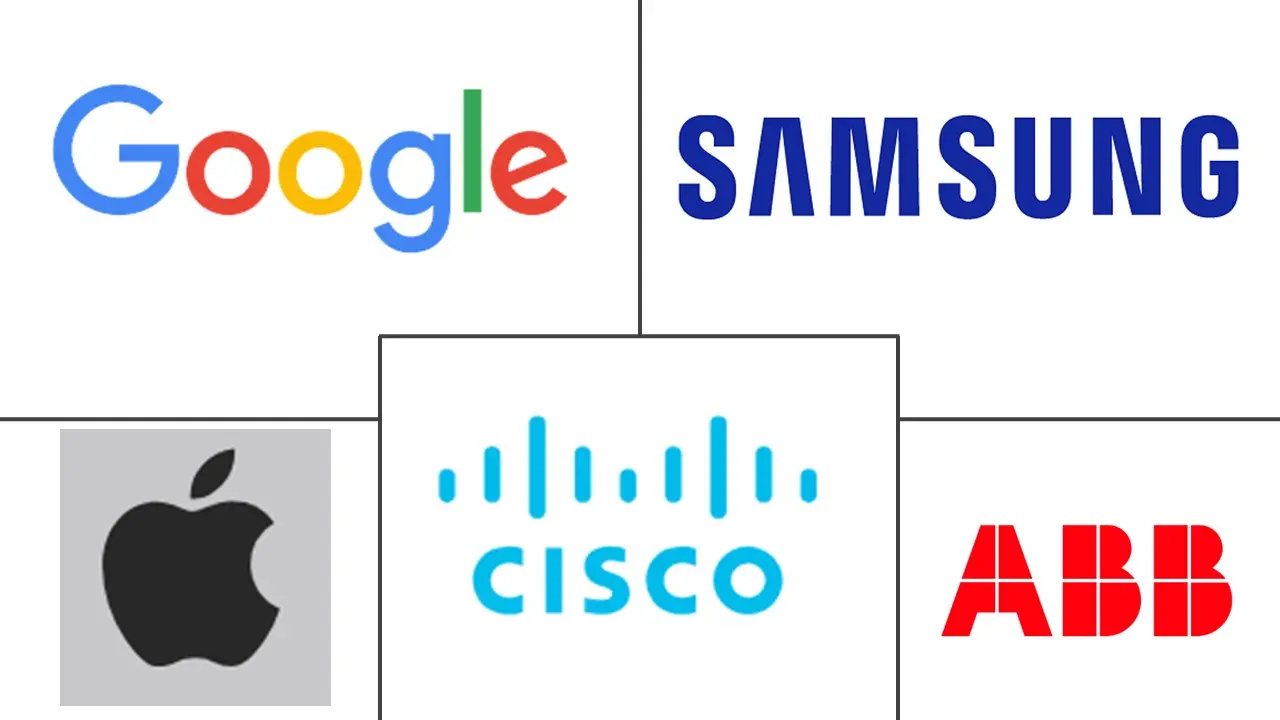
*Disclaimer: Major Players sorted in no particular order |
IoT Devices Market Analysis
The IoT Devices Market is expected to register a CAGR of 23.25% during the forecast period.
The Internet of Things (IoT) landscape is experiencing a significant transformation driven by technological convergence and standardization efforts. According to Cisco's projections, IoT devices will constitute 50% of all networked devices by 2023, reaching approximately 14.7 billion connected devices globally. The industry is witnessing a shift toward standardized solutions, with the IEEE 802 standards committee defining wireless personal area network (WPAN) protocols for IoT applications. This standardization push aims to enable interoperability across platforms, reduce implementation costs, and foster innovation through open standards. The emergence of unified communication protocols and cross-platform compatibility initiatives is reshaping how Internet of Things devices interact and share data across different ecosystems.
Enterprise adoption of IoT solutions is undergoing a notable evolution, with organizations increasingly favoring simplified implementation approaches. According to a recent Oracle survey, 64% of IoT decision-makers now prefer "off-the-shelf" IoT solutions over custom-built alternatives, indicating a significant shift in procurement strategies. This preference is driven by the desire for faster deployment times, reduced complexity, and more predictable implementation outcomes. The trend toward packaged solutions is accompanied by growing demand for integrated data analytics capabilities and connectivity features, as organizations seek to maximize the value of their IoT hardware investments while minimizing implementation challenges.
The integration of 5G technology is revolutionizing IoT capabilities and applications across industries. With theoretical speeds reaching up to 10Gbps and significantly reduced latency, 5G networks are enabling more sophisticated IoT devices applications in areas such as autonomous vehicles, industrial automation, and smart infrastructure. According to Aruba Networks, approximately 85% of businesses are expected to implement IoT technology, highlighting the growing recognition of IoT's strategic importance. The combination of 5G and IoT is particularly transformative in industrial settings, where high-bandwidth, low-latency communications enable real-time monitoring, predictive maintenance, and automated decision-making.
The convergence of IoT with emerging technologies like artificial intelligence, edge computing, and cloud services is creating new possibilities for data processing and analysis. Edge computing capabilities are becoming increasingly critical for IoT implementations, enabling real-time data processing closer to the source and reducing the strain on network infrastructure. This architectural shift is particularly important for applications requiring immediate response times, such as industrial safety systems and autonomous operations. The integration of AI and machine learning algorithms with IoT sensors is enabling more sophisticated data analysis, predictive capabilities, and automated decision-making processes, fundamentally changing how organizations leverage IoT-generated data for business intelligence and operational optimization.
IoT Devices Market Trends
Steady Growth in Demand for Connected/Smart IoT Devices in Key Segments
The increasing adoption of connected devices across various sectors is fundamentally transforming business operations and consumer experiences. According to Cisco's projections, IoT devices will constitute 50% of all networked devices by 2023, representing approximately 14.7 billion connected devices, a significant increase from 6.1 billion in 2018. This growth is particularly evident in the healthcare sector, where the rising focus on preventive healthcare and remote patient monitoring has accelerated the adoption of IoT devices. The development of sophisticated medical IoT applications, such as electrocardiogram monitors for detecting irregular heartbeats and smart insulin pens for diabetes management, demonstrates the expanding capabilities and applications of intelligent devices in critical healthcare scenarios.
The industrial sector has emerged as another key driver for IoT device adoption, with approximately 85% of businesses expected to implement IoT technology according to Aruba Networks. The integration of industrial IoT devices in manufacturing processes has become essential for predictive maintenance, quality control, and operational efficiency improvements. In the Asia-Pacific region, particularly, the transition toward automation and smart manufacturing has been accelerated by rising labor costs and the need for enhanced productivity. The implementation of connected sensors, quality diagnostic software, and flexible interfaces with secured hierarchical access has enabled manufacturers to achieve continued quality deliveries while minimizing operational costs.
Software Innovations and Improvements in Connectivity Technologies to Drive Market Growth
The advancement in software capabilities and connectivity technologies is significantly reducing the replacement cycle of IoT devices while expanding their functionality and efficiency. The emergence of edge computing solutions has revolutionized data processing capabilities, enabling real-time applications and reducing latency in IoT networks. These improvements are particularly crucial for applications requiring instantaneous response times, such as autonomous vehicles and industrial automation systems. The integration of artificial intelligence and machine learning capabilities into IoT platforms has enhanced predictive analytics and decision-making capabilities, making these systems more valuable for businesses across various sectors.
The rollout of 5G networks and improvements in low-power wide-area (LPWA) technologies are creating new possibilities for IoT applications. These connectivity advancements are enabling faster data transmission, improved device battery life, and more reliable connections for IoT devices. For instance, the development of narrowband IoT (NB-IoT) and LTE-M technologies has made it possible to deploy IoT solutions in previously challenging environments, such as underground facilities and remote locations. The continuous evolution of wireless standards and protocols is also addressing key concerns related to device interoperability and network security, making IoT solutions more attractive for enterprise adoption and encouraging faster replacement cycles to leverage these technological improvements.
Segment Analysis: By Application
Connected and Smart Home Segment in IoT Devices Market
The Connected and Smart Home segment continues to dominate the global IoT devices market, commanding approximately 40% market share in 2024. This significant market position is driven by the increasing adoption of smart home devices, voice-controlled smart devices, and integrated security solutions. The segment's growth is further bolstered by the rising consumer demand for energy-efficient solutions, automated lighting systems, and smart thermostats. Major technology companies are actively developing new smart home devices with enhanced connectivity features and AI integration, while the proliferation of voice assistant modules has significantly contributed to the segment's market leadership. The integration of multiple smart devices through unified home automation platforms has made these solutions more accessible and user-friendly for consumers, further cementing the segment's dominant position in the market.
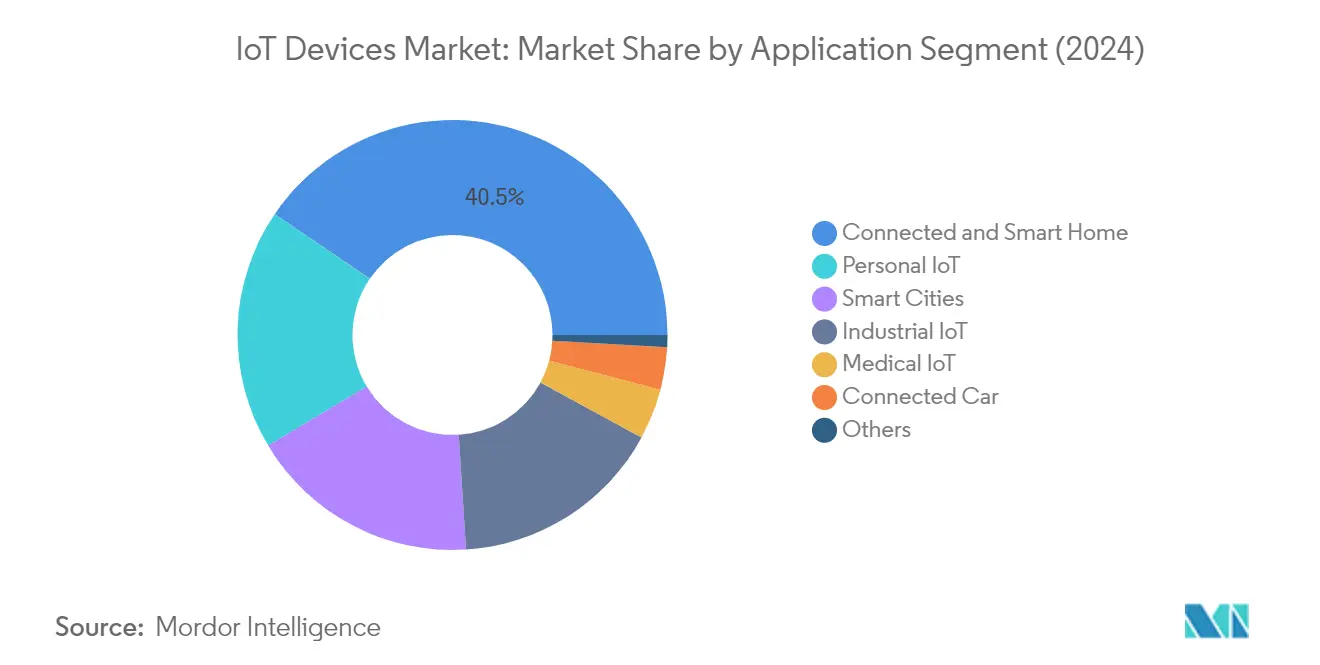
Medical IoT Segment in IoT Devices Market
The Medical IoT segment is emerging as the fastest-growing segment in the IoT devices market, with an expected growth rate of approximately 31% during 2024-2029. This remarkable growth is primarily driven by the increasing adoption of remote patient monitoring systems, smart wearable medical IoT devices, and connected healthcare solutions. The segment is witnessing rapid innovation in areas such as real-time patient monitoring, advanced diagnostics through smart image analysis, and robotic surgery applications. Healthcare facilities are increasingly implementing IoT-enabled solutions for improving operational efficiency and patient care quality. The integration of AI and machine learning with medical IoT devices is creating new opportunities for preventive healthcare and personalized medicine, while the development of smart hospitals utilizing IoT-connected technologies and robotics is further accelerating the segment's growth.
Remaining Segments in IoT Devices Market
The IoT devices market encompasses several other significant segments including Smart Cities, Industrial IoT, Personal IoT, and Connected Car applications. The Smart Cities segment is driving innovation in urban infrastructure management, including traffic control systems, public safety solutions, and smart utility management. Industrial IoT devices are revolutionizing manufacturing processes through automated systems, predictive maintenance, and smart factory solutions. The Personal IoT segment continues to evolve with advanced wearable technologies and consumer electronics, while the Connected Car segment is transforming automotive technology through advanced driver assistance systems and vehicle connectivity solutions. Each of these segments contributes uniquely to the overall market ecosystem, addressing specific industry needs and driving technological advancement in their respective domains.
Segment Analysis: By Connectivity Type
WPAN Segment in IoT Devices Market
The Wireless Personal Area Network (WPAN) segment continues to dominate the IoT devices market, holding approximately 34% market share in 2024. This significant market position is driven by WPAN's crucial role in enabling private networks for connected devices through technologies like Bluetooth, Z-wave, and infrared communications. The segment's prominence is particularly evident in medical applications, including vital sign monitoring, respiration monitoring, and electrocardiography (ECG), where WPAN technologies enable efficient data exchange between devices. The technology's advantages of low cost, quick installation, and flexibility in creating small personal networks have made it particularly attractive for both consumer and enterprise applications. Additionally, the segment's growth is supported by increasing adoption in smart home devices and wearable technologies, where short-range communication capabilities are essential for device interconnectivity.
LPWA Segment in IoT Devices Market
The Low Power Wide Area (LPWA) segment is emerging as the fastest-growing segment in the IoT devices market, with an expected growth rate of approximately 24% from 2024 to 2029. This remarkable growth is primarily driven by the increasing adoption of LPWA technologies in large-scale IoT deployments, particularly in smart city and industrial applications. The segment's growth is further accelerated by the evolution of 5G network functionality with LPWA technology, maximizing the value proposition for IoT implementations. The two most widely used LPWA solutions, Cat-M and NB-IoT, are experiencing rapid adoption across various industries, supported by telecom providers worldwide. The technology's ability to provide low power consumption, extended standby time, and cost-effective connectivity solutions makes it particularly attractive for applications requiring long-range communication with minimal power usage.
Remaining Segments in IoT Devices Market by Connectivity Type
The remaining segments in the IoT devices connectivity market include WLAN, Cellular/M2M, and other connectivity types such as WNAN and wired solutions. The WLAN segment maintains a strong presence in the market, particularly in enterprise and commercial applications where high-speed data transfer and extensive coverage are essential. The Cellular/M2M segment plays a crucial role in applications requiring wide-area coverage and mobility, especially in automotive and industrial IoT implementations. Other connectivity types, including WNAN and wired solutions, continue to serve specific niche applications where traditional connectivity methods remain advantageous, such as in industrial settings requiring highly reliable and secure connections.
IoT Devices Market Geography Segment Analysis
IoT Devices Market in North America
North America represents a dominant force in the global IoT devices market, holding approximately 28% of the market share in 2024. The region's leadership position is driven by its advanced technological infrastructure, high adoption rates of smart devices, and a strong presence of major technology companies. The United States and Canada demonstrate particularly robust growth in IoT adoption across various sectors, including manufacturing, healthcare, and smart home devices applications. The region's emphasis on digital transformation initiatives, coupled with substantial investments in research and development, continues to fuel market expansion. Additionally, the widespread implementation of 5G networks and favorable regulatory environments have created an ecosystem conducive to IoT innovation. The presence of sophisticated industrial automation systems, smart city initiatives, and an increasing focus on connected healthcare solutions further strengthens North America's position in the global IoT devices market landscape.
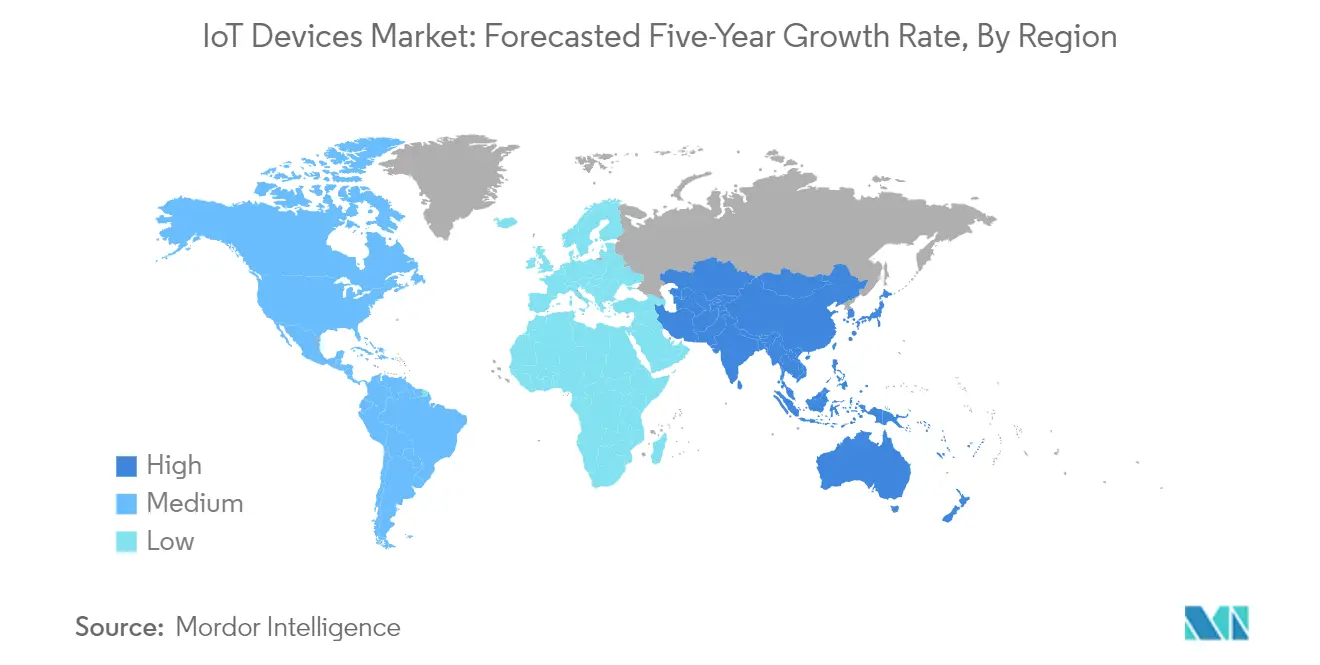
IoT Devices Market in Europe
Europe has demonstrated remarkable progress in IoT device adoption, with a substantial growth rate of approximately 22% from 2019 to 2024. The region's market development is characterized by strong governmental support for digital transformation initiatives and Industry 4.0 implementation. Countries like Germany, the United Kingdom, and the Netherlands are leading the charge in IoT adoption, particularly in manufacturing, automotive, and smart city applications. The European Union's comprehensive digital strategy and significant investments in technological infrastructure have created a robust foundation for IoT device deployment. The region's focus on sustainability and energy efficiency has driven increased adoption of IoT solutions in building automation and energy management systems. Furthermore, the strong emphasis on data protection and privacy regulations has led to the development of more secure and compliant IoT solutions, making Europe a model for responsible IoT implementation.
IoT Devices Market in Asia-Pacific
The Asia-Pacific region stands as the fastest-growing market for IoT devices, with a projected growth rate of approximately 25% from 2024 to 2029. This region's dynamic market environment is shaped by rapid industrialization, increasing urbanization, and aggressive digital transformation initiatives across multiple sectors. Countries like China, Japan, and South Korea are at the forefront of IoT innovation, particularly in manufacturing and smart city applications. The region's massive population base, coupled with increasing digital literacy and smartphone penetration, creates unprecedented opportunities for IoT device adoption. Government initiatives supporting smart city development, industrial automation, and digital infrastructure development are driving market expansion. The region's manufacturing sector is increasingly embracing Industry 4.0 principles, while the consumer segment shows a strong appetite for smart devices and wearable devices.
IoT Devices Market in Latin America
Latin America represents an emerging market with significant potential in the IoT devices sector, characterized by rapid urbanization and increasing digital transformation initiatives. The region's market is driven by growing adoption of IoT solutions in sectors such as agriculture, manufacturing, and smart city applications. Brazil and Mexico lead the regional market, with substantial investments in digital infrastructure and IoT deployment. The region's focus on improving industrial efficiency and agricultural productivity through technology adoption creates substantial opportunities for IoT device implementation. Growing awareness about the benefits of connected devices, combined with increasing internet penetration and smartphone adoption, is driving market growth. Additionally, government initiatives supporting digital transformation and smart city development are creating favorable conditions for IoT device adoption across various sectors.
IoT Devices Market in Middle East & Africa
The Middle East and Africa region presents unique opportunities in the IoT devices market, driven by ambitious smart city initiatives and digital transformation programs. The Gulf Cooperation Council countries are leading the adoption of IoT technologies, particularly in public administration and smart city applications. The region's substantial investments in infrastructure modernization and digital transformation are creating new avenues for IoT device deployment. The oil and gas sector remains a significant driver of IoT adoption, with increasing implementation of IoT sensors and monitoring systems. The region's focus on diversifying economies away from traditional sectors is spurring investments in technology and digital infrastructure. Furthermore, the growing emphasis on sustainable development and smart infrastructure is creating new opportunities for IoT device implementation across various sectors.
IoT Devices Industry Overview
Top Companies in IoT Devices Market
The IoT devices market features prominent players like Apple, Samsung, Google, ABB, Cisco, Sony, LG Electronics, and Siemens leading the innovation frontier. These IoT devices companies are heavily investing in research and development to create differentiated product offerings, with a particular focus on smart devices, industrial IoT solutions, and connected devices technologies. Strategic partnerships and collaborations have become increasingly common as companies seek to combine their technological expertise with domain knowledge. Companies are prioritizing the development of integrated solutions that offer seamless connectivity, enhanced security features, and improved user experiences. The market is characterized by continuous product launches and upgrades, with companies focusing on incorporating artificial intelligence, machine learning, and advanced analytics capabilities into their IoT devices. Operational agility is being achieved through streamlined manufacturing processes, robust supply chain management, and strategic geographical expansion to serve emerging markets.
Consolidated Market with Strong Global Players
The IoT devices market demonstrates a relatively consolidated structure dominated by large multinational technology conglomerates with diverse product portfolios. These established players leverage their strong brand recognition, extensive distribution networks, and significant financial resources to maintain their market positions. The market witnesses a mix of pure-play IoT device vendors and diversified technology companies that offer IoT solutions as part of their broader product ecosystem. Regional players maintain their presence through specialized offerings and strong local market understanding, though their scale remains limited compared to global leaders.
The market has seen considerable merger and acquisition activity as companies seek to expand their technological capabilities and market reach. Large players are actively acquiring innovative startups and smaller companies to strengthen their IoT portfolios and gain access to new technologies and markets. Strategic partnerships between hardware manufacturers, software providers, and connectivity solution providers are becoming increasingly common to create comprehensive IoT ecosystems. Companies are also forming alliances with industry-specific players to develop targeted solutions for sectors such as manufacturing, healthcare, and automotive.
Innovation and Integration Drive Market Success
For incumbent players to maintain and expand their market share, focusing on continuous innovation and product differentiation is crucial. Companies need to invest in developing proprietary technologies while ensuring interoperability with other devices and platforms. Building strong service and support networks, maintaining high quality standards, and offering comprehensive solutions that address specific industry needs are essential strategies. Successful players are those that can effectively integrate their IoT devices with existing infrastructure while providing robust security features and reliable performance.
New entrants and challenger brands can gain ground by identifying and serving underserved market segments or geographical regions. Success factors include developing specialized solutions for specific industries, offering competitive pricing without compromising quality, and building strong partnerships with established players in complementary segments. Companies must navigate regulatory requirements across different regions, particularly concerning data privacy and security. The market's future success increasingly depends on addressing end-user concerns about device security, data privacy, and seamless integration with existing systems, while also maintaining compliance with evolving regulatory frameworks.
IoT Devices Market Leaders
-
Apple Inc.
-
ABB Limited
-
Cisco Systems Inc
-
Google Inc. (Alphabet)
-
Samsung Electronics Co. Limited
- *Disclaimer: Major Players sorted in no particular order
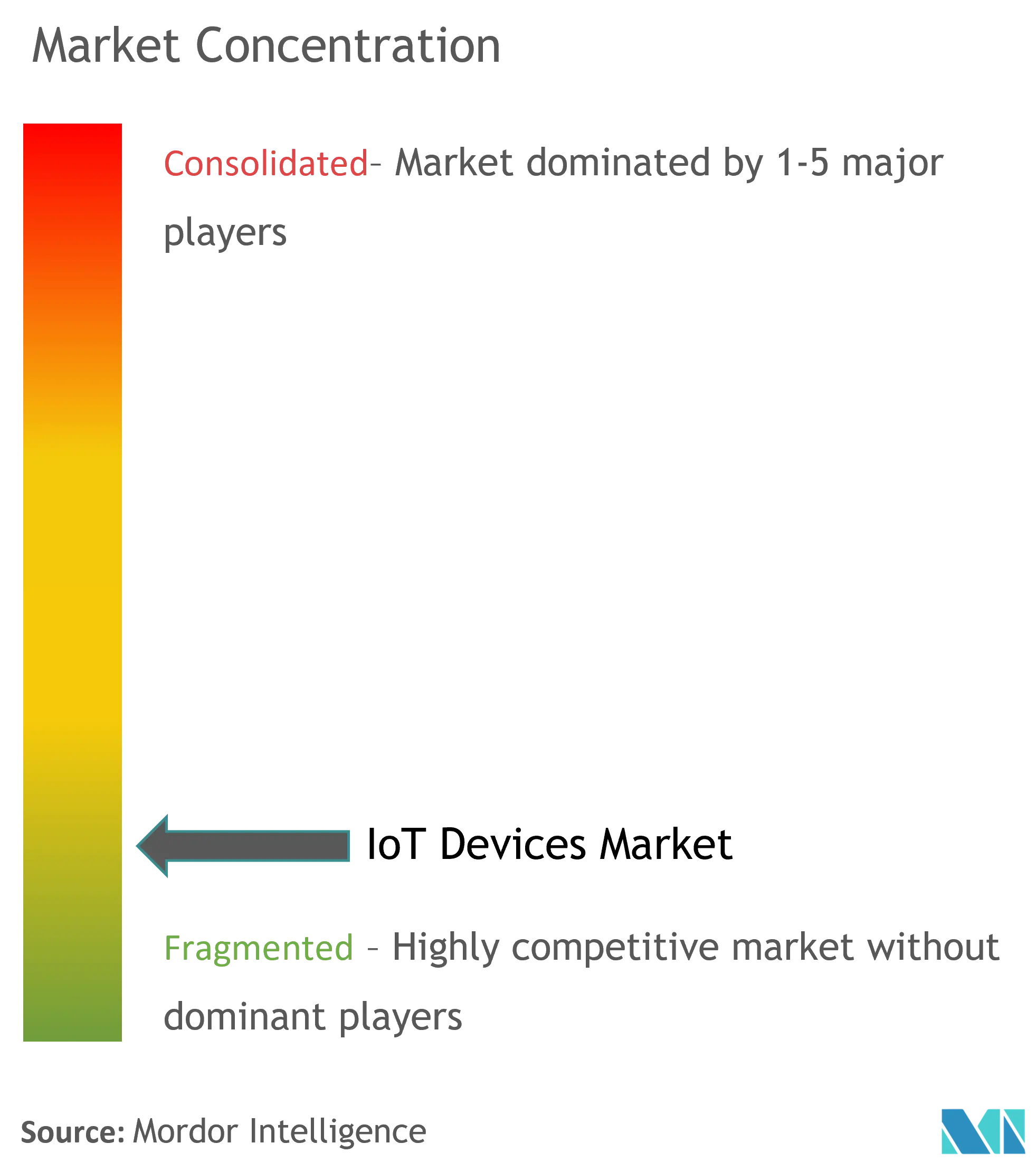
IoT Devices Market News
- June 2023: Qualcomm Launched new satellite IoT solutions to provide uninterrupted remote monitoring and asset tracking. The new modems, launched in collaboration with Skylo, an NTN service provider, enabled ultra-low power and superior connectivity for IoT devices across satellite and cellular networks. The new modems follow the 3GPP-released 17 standards for satellite communications on GEO/GSO satellites, making connectivity available globally and providing easy device setup and orientation. Both chipsets support the Qualcomm Aware platform, which provides real-time asset tracking and device management in remote areas to support critical decision-making.
- November 2022: Honeywell introduced a new sustainability system for monitoring and optimizing carbon emissions, which it has offered for early adopters and installed at its site. Honeywell Versatilis Signal Scout Wireless Industrial IoT leak detection sensors and Honeywell Forge Sustainability Plus for Industrials Emissions Management will enable enterprises to monitor and visualize emissions in near real-time. The new solution will assist industrial customers in their efforts to cut greenhouse gas (GHG) emissions and meet carbon reduction targets.
- September 2022: To deliver complete IoT asset-tracking solutions for New Zealand businesses, Vodafone NZ, the largest IoT connection provider in New Zealand, collaborated with Digital Matter, a world player in GPS and IoT asset-tracking hardware and software. Through this collaboration, Vodafone NZ has combined several battery-operated IoT asset tracking devices from Digital Matter with white-label asset tracking software, best-in-class LTE-M (Cat-M1), NB-IoT connectivity, and in-house technical support to create a fully managed, end-to-end asset management solution.
IoT Devices Market Report - Table of Contents
1. INTRODUCTION
- 1.1 Study Assumptions and Market Definition
- 1.2 Scope of the Study
2. RESEARCH METHODOLOGY
3. EXECUTIVE SUMMARY
4. MARKET INSIGHTS
- 4.1 Market Overview
-
4.2 Industry Attractiveness - Porter's Five Forces Analysis
- 4.2.1 Bargaining Power of Suppliers
- 4.2.2 Bargaining Power of Buyers
- 4.2.3 Threat of New Entrants
- 4.2.4 Threat of Substitutes
- 4.2.5 Intensity of Competitive Rivalry
- 4.3 Industry Stakeholder Analysis
- 4.4 IoT Lifecycle Analysis
5. MARKET DYNAMICS
-
5.1 Market Drivers
- 5.1.1 Steady Growth in Demand for Connected/Smart IoT Devices in Key Segments
- 5.1.2 Software Innovations and Improvements in Connectivity Technologies to drive market growth (by Lowering Replacement Cycle)
-
5.2 Market Restraints
- 5.2.1 Lack of Standardization of Communication Protocol across Different Platforms
- 5.2.2 Issues Related to Security and Privacy of Data to Hinder the Adoption of IoT Devices
- 5.3 Industry Regulations - ISO/IEC JTC, ETSI, ITU, etc.
- 5.4 Pricing Analysis
6. TECHNOLOGY SNAPSHOT
- 6.1 Evolution of IoT
- 6.2 Analysis of Key Disruptive Technologies Expected to Aid Adoption
- 6.3 Analysis of Major IoT Components
7. MARKET SEGMENTATION
-
7.1 By Application Type
- 7.1.1 Connected and Smart Home
- 7.1.2 Medical IoT
- 7.1.3 Connected Car
- 7.1.4 Smart Cities
- 7.1.5 Industrial IoT
- 7.1.6 Personal IoT
- 7.1.7 Other Application Type
-
7.2 By Connectivity Type
- 7.2.1 WPAN
- 7.2.2 WLAN
- 7.2.3 LPWA
- 7.2.4 Cellular/M2M
- 7.2.5 Other Connectivity Type
-
7.3 By Geography
- 7.3.1 North America
- 7.3.2 Europe
- 7.3.3 Asia Pacific
- 7.3.4 Latin America
- 7.3.5 Middle East and Africa
8. COMPETITIVE LANDSCAPE
-
8.1 Company Profiles
- 8.1.1 Apple Inc.
- 8.1.2 ABB Limited
- 8.1.3 Cisco Systems Inc
- 8.1.4 Google Inc. (Alphabet)
- 8.1.5 Samsung Electronics Co. Limited
- 8.1.6 LG Electronics
- 8.1.7 Siemens AG
- 8.1.8 Honeywell International Inc.
- 8.1.9 Sony Corporation
- 8.1.10 Amazon.com, Inc.
- 8.1.11 Robert Bosch GMBH
- *List Not Exhaustive
9. INVESTMENT ANALYSIS
10. FUTURE OF THE MARKET
IoT Devices Industry Segmentation
IoT is a network of internet-connected objects. These objects collect and exchange data using sensors embedded within them. IoT systems connect specialized devices designed for specific purposes with limited programmability and customizability. Moreover, IoT systems also store and process data in a distributed manner.
The IoT Devices Market is segmented by Application type (connected & smart home, medical IoT, connected car, smart cities, industrial IoT, personal IoT), by connectivity type (WPAN, WLAN, LPWA, cellular/M2M), by geography (North America, Europe, Asia Pacific, Latin America, Middle East and Africa).
The market sizes and forecasts are provided in terms of value in USD for all the above segments.
| By Application Type | Connected and Smart Home |
| Medical IoT | |
| Connected Car | |
| Smart Cities | |
| Industrial IoT | |
| Personal IoT | |
| Other Application Type | |
| By Connectivity Type | WPAN |
| WLAN | |
| LPWA | |
| Cellular/M2M | |
| Other Connectivity Type | |
| By Geography | North America |
| Europe | |
| Asia Pacific | |
| Latin America | |
| Middle East and Africa |
IoT Devices Market Research FAQs
What is the current IoT Devices Market size?
The IoT Devices Market is projected to register a CAGR of 23.25% during the forecast period (2025-2030)
Who are the key players in IoT Devices Market?
Apple Inc., ABB Limited, Cisco Systems Inc, Google Inc. (Alphabet) and Samsung Electronics Co. Limited are the major companies operating in the IoT Devices Market.
Which is the fastest growing region in IoT Devices Market?
Asia Pacific is estimated to grow at the highest CAGR over the forecast period (2025-2030).
Which region has the biggest share in IoT Devices Market?
In 2025, the North America accounts for the largest market share in IoT Devices Market.
What years does this IoT Devices Market cover?
The report covers the IoT Devices Market historical market size for years: 2019, 2020, 2021, 2022, 2023 and 2024. The report also forecasts the IoT Devices Market size for years: 2025, 2026, 2027, 2028, 2029 and 2030.
Our Best Selling Reports
IoT Devices Market Research
Mordor Intelligence provides a comprehensive analysis of the IoT devices market, utilizing our extensive experience in tracking connected devices and emerging technologies. Our research covers the full range of Internet of Things devices, including smart home devices, industrial IoT devices, and consumer IoT devices. The report offers detailed insights into developments in IoT hardware, innovations in IoT sensors, and the evolution of IoT edge devices. This gives stakeholders a complete view of both the connected equipment and intelligent devices landscapes.
Our detailed analysis benefits IoT device vendors and industry participants by providing actionable insights into the deployment of connected sensors, adoption trends in IoT equipment, and strategies for integrating IoT endpoints. The report, available as an easy-to-download PDF, covers crucial aspects such as IoT device regulations, the implementation of wireless IoT devices, and the development of embedded IoT devices. Stakeholders gain valuable perspectives on smart connected devices, wireless sensor devices, and the broader smart devices industry. This is supported by comprehensive data on IoT sensors market dynamics and emerging opportunities in the connected devices market.




